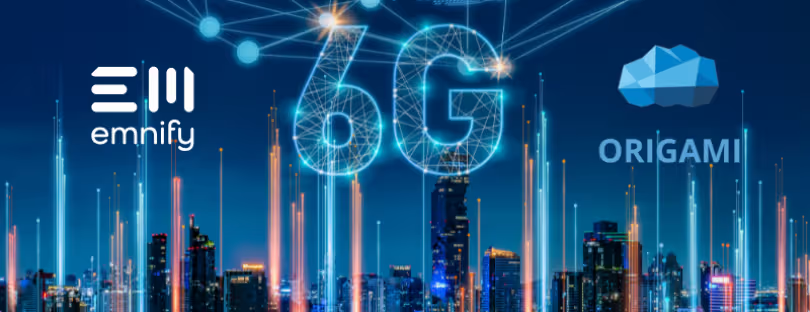
emnify Steps Into 6G Research With Bold EU-Funded Projects
emnify, the cloud-native IoT connectivity provider powering devices in more than 190 countries, has taken a front-row seat in shaping the future of mobile networks. Its participation in ORIGAMI—short for Optimized Resource Integration and Global Architecture for Mobile Infrastructure for 6G—signals how the company plans to influence the next generation of global connectivity long before it reaches commercial rollout.
The EU-funded project gathers some of Europe’s strongest R&D players, including Telefónica Research, NEC Laboratories Europe, and the University of Würzburg. Together, they’re building what could become the foundation of 6G: a smarter, greener, more interoperable global network architecture.
And emnify brings something the project deeply needs—real-world IoT traffic, challenges, and operator logic.
Why ORIGAMI matters for the future of global IoT
While 5G still expands worldwide, researchers are already tackling gaps that must be fixed before 6G can reliably support billions of devices, satellites, edge workloads, and ultra-low-latency applications.
ORIGAMI’s work centers around three pillars:
Global Service-Based Architecture (GSBA)
A blueprint for seamless interoperability between operators, clouds, satellites, and edge systems.
Zero-Trust Exposure Layer (ZTL)
Security designed for a world where trust cannot be assumed anywhere—not at the network level, device level, or API level.
Compute Continuum Layer (CCL)
A model that allows computing resources to shift dynamically between local, edge, cloud, and satellite systems depending on needs.
Put simply: if 5G networks gave us speed, 6G aims to give us intelligence, automation, and borderless integration.
emnify’s role is to test ORIGAMI’s ideas against real connectivity scenarios—global roaming, IoT provisioning, multi-network failover—and show where current architectures collapse under international scale.
A German hub for 6G innovation
Earlier this year, emnify hosted the ORIGAMI consortium in Würzburg as part of the mid-term review. One highlight was the company’s new observability platform for globally distributed latency and availability monitoring—technology that gives operators visibility into how roaming partners behave across continents.
For future 6G environments, where devices may move between terrestrial and satellite networks in milliseconds, this type of visibility is not “nice to have”—it’s essential.
emnify CTO Artur Michalczyk put it bluntly:
“We’re not only preparing for the 6G era—we’re helping define how IoT devices will connect, communicate, and stay secure on a global scale.”
Expanding cooperation: AI, LEO satellites, and intelligent networks
Building on ORIGAMI, emnify also secured funding for NaSA-OMI, a Bavarian government-supported research initiative with the University of Würzburg. The project focuses on:
- AI-based anomaly detection
- Network intelligence
- Non-Terrestrial Networks (NTN), including LEO satellite integration
This is exactly the direction the mobile industry is moving. According to the 3GPP and recent GSMA Intelligence forecasts, NTN will become a core part of 5G-Advanced and 6G—not a separate system. Players like SpaceX, AST SpaceMobile, Lynk Global, and satellite-connected eSIM providers are already pushing the boundaries. emnify entering this space from an IoT-centric angle is strategically smart.
As Prof. Tobias Hoßfeld from the University of Würzburg noted, the collaboration lets researchers test emerging concepts against real IoT behaviour—thousands of device types, numerous roaming partners, and unpredictable traffic patterns.
How emnify’s strategy compares to other IoT leaders
While competitors like 1NCE, KORE Wireless, Eseye, and Soracom also participate in emerging IoT standards and collaborations, emnify is distinguishing itself in two specific ways:
1. Deep integration with academic research
Few IoT connectivity providers embed themselves directly into EU-level 6G architecture working groups. This gives emnify early influence—and early access—to the networks that will define IoT in the 2030s.
2. Strong positioning in cloud-native operator models
emnify’s SuperNetwork architecture already aligns with many ORIGAMI concepts: global roaming without physical core networks, real-time observability, and API-driven connectivity. This positions the company to adopt 6G-style architectures faster than traditional MNOs and MVNOs.
Reliable sources, including the European SNS JU, GSMA’s 6G Forum, and Ericsson’s and Nokia’s 6G research hubs, consistently highlight the same trend: IoT providers who adopt cloud-native and NTN-ready architectures early will have a competitive edge when 6G commercialization begins around 2030–2032.
emnify clearly intends to be one of them.
Conclusion: emnify isn’t just preparing for 6G—it’s positioning itself to lead
What stands out most is how strategically emnify is moving compared to other IoT connectivity providers. While many players focus on pricing or SIM management features, emnify is investing in the backbone technologies that will actually shape global IoT for the next decade: security layers, satellite integration, cloud-native cores, and intelligent observability.
For enterprises deploying connected devices worldwide—from logistics to travel tech, hospitality, aviation, mobility, and smart energy—this is a signal worth noting.
The companies shaping 6G today will be the ones defining IoT connectivity tomorrow.
And emnify has clearly chosen its side: not following the industry, but helping design its future.












